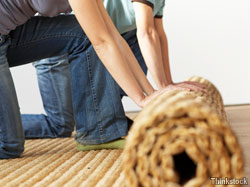(ARA) – You know that moving into a new home can be one of life’s biggest stressors – the packing, the paperwork, the unpacking, finding the nearest coffee shop … even though numbers are down, 35.2 million Americans changed residences in 2008, according to a report by the U.S. Census Bureau. There are many ways to make your new house feel like home sooner than later, according to interior design faculty at The Art Institutes.
“Incorporating items with personal meaning, such as memorabilia or a special collection, can make your new place feel less like a stranger’s house and more like your home,” says Annette Lawrence, academic director of the Interior Design program at The Art Institute of Ohio – Cincinnati. Lawrence describes the concept of “adaptive re-use,” an easy, inexpensive way to create a “sense of place” – in other words, making your new house the place in which you feel most comfortable – home.
Adaptive re-use involves bringing items from your previous residence to your new home, but with the twist of adapting them for a different or new use. Adaptive re-use is affordable, ecologically responsible and helps ease the psychological stresses that come with moving into a new, unfamiliar space. Adaptive re-use also involves using items from local design consignment shops. Such establishments can now be found in most towns and carry items ranging from furniture to window treatments and accessories.
Some examples of adaptive re-use:
* Same item, same use – The entry rug from your old house goes in the entryway of the new house.
* Same item, different location – Your living room furniture from your old home becomes your family room furniture in your new place.
* Same item, new use – You use the fabric from a window treatment to upholster your dining room chairs.
“Mies van der Rohe’s old adage, ‘less is more,’ certainly holds true here,” says Jackie Barry, interior design instructor at The Art Institute of Houston – North, a branch of The Art Institute of Houston. “Select significant pieces of furniture and art to move. You don’t need to have or show everything you have all in one room.”
Barry also advises incorporating a concept called biophilic design, which recognizes the inherent need of humans to interact and affiliate with nature to achieve and maintain optimum health and well-being. “Bring the outside in; don’t neglect good views to the outside, accentuate them,” she says. “Let your garden and landscaping work for you on the inside. Connecting with nature can also have a calming and a comforting effect.”
If all of this still feels too overwhelming to you, consider hiring a professional interior designer to help you out. Lawrence suggests using personal contacts and references to find a designer who is right for you.
Courtesy of ARAcontent

